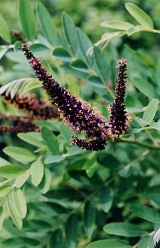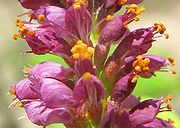
Amorpha
Encyclopedia
Amorpha is a genus of plants in the pea family Fabaceae
. All the species are native to North America
, from southern Canada
, most of the United States
, and northern Mexico
. They are commonly known as false indigo. The name Amorpha means "deformed" in Greek and was given because flowers of this genus only have one petal, unlike the usual "pea-shaped" flowers of the Faboideae
subfamily. Amorpha is missing the wing and keel petals.
 The desert false indigo, or indigo bush, Amorpha fruticosa, is a shrub that grows from 3 m to 5 m tall. In some areas it is considered an invasive plant
The desert false indigo, or indigo bush, Amorpha fruticosa, is a shrub that grows from 3 m to 5 m tall. In some areas it is considered an invasive plant
. It has escaped it's native range to spread across North America and been introduced in Europe
.
The lead plant (A. canescens) is a North America
n prairie
forb
. This bushy shrub is an important native prairie legume. Lead plant is often associated with bluestem
grasses. Native Americans
used the dried leaves for pipe smoking and for tea.
Amorpha species are used as food plants by the larva
e of some Lepidoptera
species including Schinia lucens
, which feeds exclusively on the genus.
Amorphol, a rotenoid
bioside can be isolated from plants of the genus Amorpha.
Fabaceae
The Fabaceae or Leguminosae, commonly known as the legume, pea, or bean family, is a large and economically important family of flowering plants. The group is the third largest land plant family, behind only the Orchidaceae and Asteraceae, with 730 genera and over 19,400 species...
. All the species are native to North America
North America
North America is a continent wholly within the Northern Hemisphere and almost wholly within the Western Hemisphere. It is also considered a northern subcontinent of the Americas...
, from southern Canada
Canada
Canada is a North American country consisting of ten provinces and three territories. Located in the northern part of the continent, it extends from the Atlantic Ocean in the east to the Pacific Ocean in the west, and northward into the Arctic Ocean...
, most of the United States
United States
The United States of America is a federal constitutional republic comprising fifty states and a federal district...
, and northern Mexico
Mexico
The United Mexican States , commonly known as Mexico , is a federal constitutional republic in North America. It is bordered on the north by the United States; on the south and west by the Pacific Ocean; on the southeast by Guatemala, Belize, and the Caribbean Sea; and on the east by the Gulf of...
. They are commonly known as false indigo. The name Amorpha means "deformed" in Greek and was given because flowers of this genus only have one petal, unlike the usual "pea-shaped" flowers of the Faboideae
Faboideae
Faboideae is a subfamily of the flowering plant family Fabaceae or Leguminosae. One acceptable alternative name for the subfamily is Papilionoideae....
subfamily. Amorpha is missing the wing and keel petals.

Invasive species
"Invasive species", or invasive exotics, is a nomenclature term and categorization phrase used for flora and fauna, and for specific restoration-preservation processes in native habitats, with several definitions....
. It has escaped it's native range to spread across North America and been introduced in Europe
Europe
Europe is, by convention, one of the world's seven continents. Comprising the westernmost peninsula of Eurasia, Europe is generally 'divided' from Asia to its east by the watershed divides of the Ural and Caucasus Mountains, the Ural River, the Caspian and Black Seas, and the waterways connecting...
.
The lead plant (A. canescens) is a North America
North America
North America is a continent wholly within the Northern Hemisphere and almost wholly within the Western Hemisphere. It is also considered a northern subcontinent of the Americas...
n prairie
Prairie
Prairies are considered part of the temperate grasslands, savannas, and shrublands biome by ecologists, based on similar temperate climates, moderate rainfall, and grasses, herbs, and shrubs, rather than trees, as the dominant vegetation type...
forb
Forb
A forb is a herbaceous flowering plant that is not a graminoid . The term is used in biology and in vegetation ecology, especially in relation to grasslands and understory.-Etymology:...
. This bushy shrub is an important native prairie legume. Lead plant is often associated with bluestem
Little bluestem
Schizachyrium scoparium, commonly known as little bluestem or beard grass, is a North American prairie grass. Little bluestem is a perennial bunchgrass and is prominent in tallgrass prairie, along with big bluestem , indiangrass and switchgrass...
grasses. Native Americans
Native Americans in the United States
Native Americans in the United States are the indigenous peoples in North America within the boundaries of the present-day continental United States, parts of Alaska, and the island state of Hawaii. They are composed of numerous, distinct tribes, states, and ethnic groups, many of which survive as...
used the dried leaves for pipe smoking and for tea.
Amorpha species are used as food plants by the larva
Larva
A larva is a distinct juvenile form many animals undergo before metamorphosis into adults. Animals with indirect development such as insects, amphibians, or cnidarians typically have a larval phase of their life cycle...
e of some Lepidoptera
Lepidoptera
Lepidoptera is a large order of insects that includes moths and butterflies . It is one of the most widespread and widely recognizable insect orders in the world, encompassing moths and the three superfamilies of butterflies, skipper butterflies, and moth-butterflies...
species including Schinia lucens
Schinia
Schinia, commonly called Flower Moths, is a large genus of moths belonging to the family Noctuidae. The genus has a Holarctic distribution with the vast majority of species being found in North America, many with a very restricted range and larval food plant.-Species Information and Food Plants:...
, which feeds exclusively on the genus.
Amorphol, a rotenoid
Rotenoid
Rotenoids are naturally occurring substances containing a cis-fused tetrahydrochromeno[3,4-b]chromene nucleus. Rotenoids are related to the isoflavones....
bioside can be isolated from plants of the genus Amorpha.
Species
- Amorpha apiculata
- Amorpha californicaAmorpha californicaAmorpha californica is a species of flowering plant in the legume family known by the common name California false indigo.It is native to California, Arizona, and northern Baja California, where it grows in the California chaparral and woodlands and other chaparral and oak woodlands...
- California false indigo, mock locust - Amorpha canescensAmorpha canescensAmorpha canescens is a 1–3 feet tall deciduous shrub in the Pea family that is native to North America. It has very small purple flowers which are grouped in racemes. The compound leaves of this plant appear leaden due to their dense hairiness...
- leadplant - Amorpha crenulata (syn.SynonymSynonyms are different words with almost identical or similar meanings. Words that are synonyms are said to be synonymous, and the state of being a synonym is called synonymy. The word comes from Ancient Greek syn and onoma . The words car and automobile are synonyms...
A. herbacea var. crenulata) - endangered - Amorpha fruticosaAmorpha fruticosaAmorpha fruticosa is a species of flowering plant in the legume family known by several common names, including desert false indigo and bastard indigobush. It is found throughout eastern Canada, northern Mexico, and most of the continental United States, but it is probably naturalized in western...
- desert false indigo - Amorpha georgiana - Georgia false indigo
- Amorpha glabra - mountain false indigo
- Amorpha herbacea - clusterspike false indigo
- Amorpha laevigata - smooth false indigo
- Amorpha nanaAmorpha nanaAmorpha nana is a 1-3 feet tall perennial shrub in the Pea family which is native to North America. It has vibrant green pinnate leaves and clusters of purple flowers. The fruits are small pods...
- dwarf false indigo - Amorpha nitens - shining false indigo
- Amorpha notha
- Amorpha ouachitensis - Ouachita false indigo
- Amorpha paniculata - panicled false indigo
- Amorpha roemeriana - Roemer's false indigo
- Amorpha schwerinii - Schwerin's false indigo

